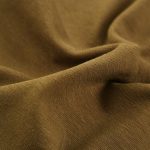Are you tired of spending hours on ironing, only to end up with wrinkled fabric? Look no further! In this article, we will share with you three proven techniques for ironing fabric efficiently.
With the right equipment, proper fabric preparation, and mastery of the correct techniques, you’ll be able to achieve wrinkle-free clothes in no time. Say goodbye to those pesky wrinkles and hello to perfectly pressed garments.
Let’s get started!
Table of Contents
Choosing the Right Ironing Equipment
To ensure efficient ironing results, you need to choose the right ironing equipment for your needs. Two key factors to consider are ironing temperature control and ironing board selection.
When it comes to ironing temperature control, it’s important to choose an iron that allows you to adjust the heat setting. Different fabrics require different temperatures to avoid damage or scorching. For delicate fabrics like silk or chiffon, you’ll want a lower temperature setting, while heavier fabrics like cotton or linen may require a higher heat setting. Look for an iron with a clear temperature dial or digital display, so you can easily adjust and monitor the heat as needed.
Equally important is the selection of the right ironing board. Look for a board that’s sturdy and stable, with a smooth and padded surface. Adjustable height options are also beneficial, allowing you to find the most comfortable and ergonomic position for ironing. Consider the size of the board too, ensuring it’s large enough to accommodate your ironing needs.
Preparing Your Fabric for Ironing
Now that you have chosen the right ironing equipment, let’s move on to preparing your fabric for ironing.
Properly preparing your fabric is crucial to achieve the best results and prevent any damage during the ironing process. Before you start ironing, it’s important to ensure that your fabric is clean and free from any dirt or stains. If your fabric is dirty, gently wash it according to the care instructions provided. Additionally, check the fabric for any loose threads or unfinished edges that may unravel during ironing. It’s advisable to trim these threads and finish any raw edges before proceeding.
Another essential step in preparing fabric for ironing is to remove any wrinkles or creases. You can do this by lightly misting the fabric with water using a spray bottle or using a steam iron to gently steam the wrinkles away. Be cautious not to oversaturate the fabric with water, as this can cause water spots or shrinkage.
Lastly, it’s important to consider the fabric type and adjust the iron temperature accordingly. Different fabrics require different heat settings, so it’s recommended to refer to the fabric care label or a temperature guide to ensure you’re using the appropriate heat level.
Mastering the Correct Ironing Techniques
Once you have prepared your fabric, it’s time to master the correct ironing techniques. Ironing can be a daunting task, but with a few tips and tricks, you can make it a breeze.
When dealing with stubborn wrinkles, try these ironing hacks: spritz the fabric with water before ironing, use steam to loosen the wrinkles, or place a damp cloth over the wrinkle and iron over it. These techniques will help you achieve a smooth and wrinkle-free finish.
If you often find yourself ironing large quantities of fabric, it’s important to have some time-saving tricks up your sleeve. One effective method is to sort your fabrics by type and temperature settings. This way, you can adjust the iron’s heat accordingly without wasting time.
Another time-saving trick is to invest in a good quality iron with a larger surface area. This will allow you to cover more fabric in one swipe, reducing the overall ironing time. Additionally, using a vertical steamer can be a quick and efficient way to remove wrinkles from hanging garments or curtains.
Effective Tips for Ironing Different Fabrics
When ironing different fabrics, it’s essential to use the appropriate heat setting to avoid damaging the material. Here are some effective tips to help you iron different fabrics efficiently:
-
Silk: Ironing silk can be challenging, as it’s delicate and prone to heat damage. To iron silk efficiently, set your iron to the lowest heat setting or use a silk setting if available. Place a thin cloth or a pressing cloth over the silk garment to protect it from direct heat. Gently press the iron onto the fabric, moving it in a back-and-forth motion. Avoid applying too much pressure or leaving the iron in one spot for too long to prevent scorching or fabric damage.
-
Cotton: Cotton is a durable fabric that can withstand higher heat settings. Set your iron to a medium-high heat setting for best results. Start ironing cotton from the inside or the reverse side of the fabric to prevent shine marks. Iron in a circular motion or along the grain of the fabric to smooth out wrinkles effectively.
-
Wool: Wool is heat-sensitive and can easily shrink if exposed to high temperatures. Set your iron to a low heat setting or use the wool setting. Place a damp cloth or a pressing cloth over the wool garment to add moisture and protect it from direct heat. Gently press the iron onto the fabric, moving it in a circular motion. Avoid stretching the fabric or applying too much pressure to prevent distortion.
-
Preventing fabric shrinkage: To prevent fabric shrinkage while ironing, avoid using high heat settings on delicate fabrics such as silk, wool, or synthetic materials. Always check the care label for ironing instructions and follow them accordingly. If in doubt, start with a lower heat setting and gradually increase as needed. Using a pressing cloth or a damp cloth can also help protect the fabric and minimize shrinkage.
Wrinkle-Free Storage and Maintenance Techniques
To maintain wrinkle-free fabric, it’s important to regularly practice proper storage and maintenance techniques.
Storing delicate fabrics correctly is crucial to preserving their quality. When storing, make sure to fold them neatly and place them in a clean, dry, and well-ventilated area. Avoid hanging delicate fabrics, as this can cause them to stretch and lose their shape.
Additionally, it’s important to prevent color fading during ironing. To do this, always sort your laundry by color and wash them separately. When ironing, use the appropriate heat setting for each fabric type and avoid leaving the iron on one spot for too long, as this can cause discoloration. It’s also recommended to use a pressing cloth to protect delicate fabrics from direct heat.
Finally, be sure to follow the care instructions on the fabric label and avoid using harsh chemicals or bleach, as they can damage the fabric and lead to wrinkles.
Frequently Asked Questions
How Often Should I Clean My Ironing Equipment?
You should clean your ironing equipment regularly to maintain its efficiency. By cleaning it frequently, you prevent the buildup of dirt and residue, ensuring smooth ironing and prolonging the lifespan of your equipment.
Can I Use a Regular Ironing Board for Ironing Delicate Fabrics?
Yes, you can use a regular ironing board for ironing delicate fabrics. However, it’s important to choose the right ironing board with a padded surface and adjustable heat settings to prevent damage.
Are There Any Specific Techniques for Ironing Pleated Garments?
When ironing pleated garments, it’s important to use specific ironing techniques. By gently pressing the pleats with a warm iron and using a steam function, you can ensure a crisp and smooth finish.
What Is the Best Way to Remove Stubborn Wrinkles From Linen Fabric?
To remove stubborn wrinkles from linen fabric, the best way is to use a steamer. It’s one of the ironing hacks that can efficiently smooth out the fabric without causing any damage.
How Can I Prevent Ironing Marks on Dark-Colored Fabrics?
To prevent ironing marks on dark-colored fabrics, first, make sure your iron is clean and free of any residue. Second, use a lower heat setting and iron inside out. Finally, place a thin cloth between the iron and the fabric to protect it.






